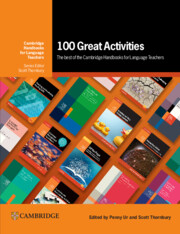6 - Grammar
Published online by Cambridge University Press: 14 March 2024
Summary
The activities in this section typically target a specific grammatical feature, and then give the learners opportunities to engage with it through an interesting task that involves conveying (written or spoken) meanings. Sometimes this means communicative interaction (‘Question stories’); sometimes just playful suggestions (‘Oh!’). In any case, they make a welcome break from the routine gapfills and transformation exercises normally provided in coursebooks and online grammar practice. You’ll find that most of the activities can be adapted to practise features other than the one focused on in the original; and others, for example ‘Sentence repetition’ or ‘Student-generated test’, you can use for any grammatical structure(s) you like!
Adjectives on the internet
From Grammar Practice Activities: A practical guide for teachers by Penny Ur
Outline Students search online for interesting contexts for a given grammatical form
Author's comment This activity was designed to practise the comparative of adjectives: but actually it can be used for almost any vocabulary item or grammatical form you like. The goal is to find a context for the target bit of language that is understood by students, and fun. An alternative would be to ask an AI generative text tool such as ChatGPT to create seven sentence contexts for the target bit of language, and then choose the most interesting.
Editors’ comment This is a simple but effective use of the vast resources of the internet for language study. And once students become accustomed to searching the internet for examples, it's not a huge step to introduce them to online corpus tools, where they can refine their searches, e.g. by searching for examples from academic writing, from conversation or from movies.
Level Elementary to Pre-intermediate (A1–B1)
Preparation None
Procedure
1 Brainstorm as many adjectives as the class can think of (up to about 30), and write them on the board.
2 Each student selects one of them and writes down its comparative form.
3 They search online for this form and find five different contexts in which it is used. These must be a) clearly understood and b) interesting or funny.
- Type
- Chapter
- Information
- Publisher: Cambridge University PressPrint publication year: 2024

